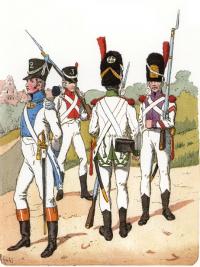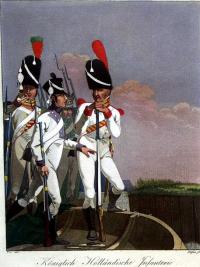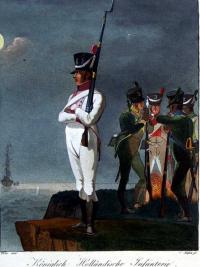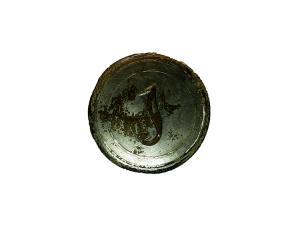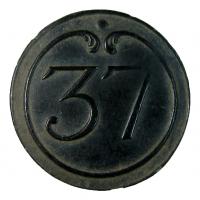Пехотные полки Голландского королевства - The Infantry regiments of the Kingdom of The Netherlands
Пехотные полки Королевства Голландия
Армия Голландии, перед тем как присоединиться к французской армии состояла из восьми полков линейной пехоты. Их номера начинались со 2-го и заканчивались 9-м.
В основнм мы будем рассматривать части армии Голландского королевства до его присоединения к Французской Империи.
В 1810 году армия Голландии в полном составе влилась во Французскую армию и пополнила её, организовав новые полки практически во всех родах войск. Так полки голландской линейной пехоты, за исключением 4-го, образовали 4 полка линейной пехоты Великой Армии и получили порядковые номера с 123-го по 126-й.
Также был организован 33-й полк лёгкой пехоты из егерьского полка королевства.
Старый Зеландский полк (Zeeland Regiment) реорганизовали в Тексельский полк (Texel Regiment) состоявший из четырёх батальонов по шесть рот в каждом. Роты насчитывали по 140 человек.
4-й полк линейной пехоты стал Полком острова Вальхерен. В 1811 году из Полка острова Вальхерен организовали 131-й полк линейной французской пехоты.
Все полки Голландского королевства переведенные во французскую пехоту не получили нового обмундирования и воевали во время Русской Кампании в старых мундирах голландской армии.
Скорее всего, новую французскую форму с пуговицами новых полков получили только элитные роты и первые батальоны этих полков. Это предположение подтверждается совсем немногочисленными находками пуговиц и других деталей униформы с номерами 123-126.
По сравнению с малым количеством находок с номерами новых полков, пуговицы относимые к королевским голландским полкам гораздо чаще попадаются на дороге отступления и местах боёв Великой Армии.
Так, например, перед деревней Студёнка недалеко от городка Старо Борисов, на бивуаке отступающей армии, были найдены пуговицы разных полков королевской Голландии и киверный знак в виде ромба. На этом знаке была изображено число 125, вписанное в егерьский рожок.
Этот киверный знак принадлежал солдату элитной вольтижерской роты 125-го полка линейной пехоты. В Стаховсом лесу часто попадались пуговицы 3-го полка а также 5-го полка пехоты Голландии.
На поле расположенном перед переправой, перед переправой через Березину, попадались большие и малые мундирные пуговицы штрафного полка острова Вальхерен.
Основная часть пуговиц с номерами 123-126 встречается по дороге отступления от Молодечно до Вильно и дальше до Ковно. Скорее всего новые рекруты, шедшие на подкрепление своим полкам и получившие уже новые мундиры, "оставили" свои пуговицы вместе с обмундированием, да и сами навеки остались возле костов на дороге до Молодечно.
Полк Гвардейских гренадер состоящий из 2-х батальонов по 4 роты в каждом, стал Третьим полком Императорской гвардии Французской империи.
The Infantry regiments of the Kingdom of The Netherlands
The Holland Army consisted of eight regiments of the line infantry before joining the French army. Their numbers were started from the 2nd and were ended by the 9th.
We mostly consider the parts of the army of the Kingdom of the Netherlands till its accession to the French Empire.
In 1810, the Holland army in their full force joined the French army and has expanded it, organizing the new shelves in almost all kinds of regiments. So the Holland line infantry regiments, with the exception of the 4th, formed 4 regiments of the line infantry and received the Grand Army of the serial numbers from the 123rd to the 126th.
There was also organized the 33rd Regiment of Light Infantry from huntsman’s Regiment of the Kingdom.
Old Zealand Regiment (Zeeland Regiment) was reorganized into Texel Regiment (Texel Regiment) consisting of four battalions with six companies in each. There were 140 people.
The 4th Regiment of Line Infantry became a Regiment of the Walcheren Island. In 1811, the Regiment of the island of Walcheren was organized in the 131st Regiment of the French line infantry.
All the regiments of the Kingdom of the Netherlands that were transferred to the French infantry have not received the new uniform and fought during the Russian campaign wearing the old uniform of the Holland army.
It is most likely, that the new French uniform with buttons of new regiments have been received by only the elite company and the first battalions of these regiments. This assumption is supported by very few findings of buttons and other parts of uniforms with numbers 123-126.
If to compare a small number of findings to the numbers of new regiments, the buttons that are attributable to the Royal Holland regiments are more often come across on the road of retreat and the places of local battles of the Great Army.
For example, in front of the village Studenka near the town of Old Borisov, there were found the buttons of different regiments of the Royal Netherlands. And there was also a shako sign in the form of diamond. This sign showed the number 125 that was inscribed in huntsman’s horn.
This shako sign belonged to an elite soldier of voltizhersky company of the 125th regiment of the line infantry. In Stahovsky forest the buttons of the 3rd Regiment and the 5th Infantry Regiment of the Netherlands often come across.
On the field that is located in front of crossing of the Berezina, there were found large and small Uniform’s buttons of penalty Regiment of the island of Walcheren.
The main part of all buttons with the numbers 123-126 is found on the road of retreating from Maladechno and Vilna to Kovno. It is most likely that the new recruits who were marching to reinforce for their regiments and who had already received the new uniform "left" their buttons with their uniforms, and forever remain near the fires on the road to Maladzechna.
The Guard Grenadiers Regiment consisting of 2 battalions with 4 companies in each became the third regiment of the Imperial Guard of the French Empire.
8 пехотный полк голландского королевства - 8 infantry regiment of the Dutch kingdom
7 пехотный полк голландского королевства - 7 infantry regiment of the Dutch kingdom
6 пехотный полк голландского королевства - 6 infantry regiment of the Dutch kingdom
5 пехотный полк голландского королевства - 5 infantry regiment of the Dutch kingdom
4 пехотный полк голландского королевства - 4 infantry regiment of the Dutch kingdom
3 пехотный полк голландского королевства - 3 infantry regiment of the Dutch kingdom
2 пехотный полк Голландского Королевства - 2 infantry regiment of the Dutch kingdom
Social


